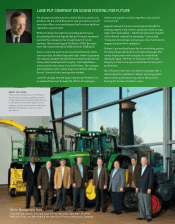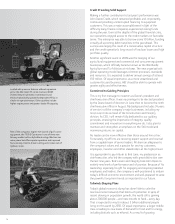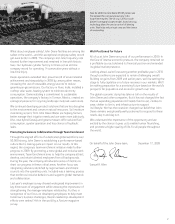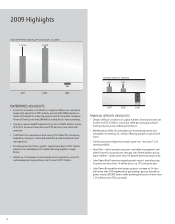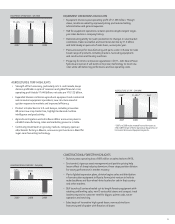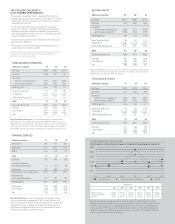John Deere 2009 Annual Report Download - page 11
Download and view the complete annual report
Please find page 11 of the 2009 John Deere annual report below. You can navigate through the pages in the report by either clicking on the pages listed below, or by using the keyword search tool below to find specific information within the annual report.
1 2
MANAGEMENT’S DISCUSSION AND ANALYSIS
RESULTS OF OPERATIONS FOR THE YEARS ENDED
OCTOBER 31, 2009, 2008 AND 2007
OVERVIEW
Organization
The company’s Equipment Operations generate revenues and
cash primarily from the sale of equipment to John Deere dealers
and distributors. The Equipment Operations manufacture and
distribute a full line of agricultural equipment; lawn and turf
care equipment, landscaping and irrigation products; and a
broad range of equipment for construction and forestry.
The company’s Financial Services primarily provide credit
services, which mainly fi nance sales and leases of equipment
by John Deere dealers and trade receivables purchased from
the Equipment Operations. In addition, Financial Services
offer certain crop risk mitigation products and invest in wind
energy generation. The information in the following discussion
is presented in a format that includes information grouped as
consolidated, Equipment Operations and Financial Services.
The company also views its operations as consisting of two
geographic areas, the U.S. and Canada, and outside the
U.S. and Canada. The company’s reportable operating segments
consist of agriculture and turf, construction and forestry and
credit. The previous agricultural equipment segment and
commercial and consumer equipment segment were combined
into the agriculture and turf segment at the beginning of the
third quarter of 2009 (see Note 28). The following discussions
of operating segment results have been revised to conform to
the current reportable segments.
Trends and Economic Conditions
Industry farm machinery sales in the U.S. and Canada in 2010
are forecast to be down about 10 percent. Industry sales in
Western Europe are forecast to decline 10 to 15 percent and
South America industry sales are projected to increase by 10 to
15 percent for the year. The company’s agriculture and turf
equipment sales declined 14 percent in 2009 and are forecast
to decrease by about 4 percent for 2010, including a favorable
currency translation impact of about 2 percent. U.S. construction
equipment markets are forecast to be down in 2010 resulting
from a decline in non-residential construction activity and lower
used equipment values. Global forestry markets are expected
to experience some recovery in 2010 based on higher demand
for pulp and paper. The company’s construction and forestry
sales declined 45 percent in 2009 and are forecast to increase
by approximately 18 percent in 2010. Net income for the
company’s credit operations in 2010 is forecast to increase to
approximately $240 million.
Items of concern include the decline in global economic
activity and expected slow recovery, capital market disruptions,
the effectiveness of governmental policies to promote economic
recovery, the availability of credit for the company’s customers
and suppliers and fi nancial regulatory reform. Signifi cant fl uctua-
tions in foreign currency exchange rates and volatility in the
price of many commodities could also impact the company’s
results. The availability of certain components that could impact
the company’s ability to meet production schedules continues
to be monitored. Designing and producing products with
engines that continue to meet high performance standards and
increasingly stringent emissions regulations is one of the
company’s major priorities.
In an environment of intense global economic pressure, the
company has completed a solidly profi table year and maintained
its strong fi nancial condition. The company’s plans for meeting
the world’s growing need for food and infrastructure are
continuing to move forward.
2009 COMPARED WITH 2008
CONSOLIDATED RESULTS
Worldwide net income in 2009 was $873 million, or $2.06
per share diluted ($2.07 basic), compared with $2,053 million,
or $4.70 per share diluted ($4.76 basic), in 2008. Included in
net income for 2009 were charges of $381 million pretax
($332 million after-tax), or $.78 per share diluted and basic,
related to impairment of goodwill and voluntary employee
separation expenses (see Note 5). Net sales and revenues
decreased 19 percent to $23,112 million in 2009, compared
with $28,438 million in 2008. Net sales of the Equipment
Operations decreased 20 percent in 2009 to $20,756 million
from $25,803 million last year. The sales decrease was primarily
due to lower shipment volumes. The decrease also included an
unfavorable effect for currency translation of 4 percent, more
than offset by price realization of 5 percent. Net sales in the
U.S. and Canada decreased 14 percent in 2009. Net sales
outside the U.S. and Canada decreased by 28 percent in 2009,
which included an unfavorable effect of 8 percent for currency
translation.
Worldwide Equipment Operations had an operating
profi t of $1,365 million in 2009, compared with $2,927 million
in 2008. The deterioration in operating profi t was primarily
due to lower shipment and production volumes, the unfavorable
effects of foreign currency exchange, a goodwill impairment
charge, higher raw material costs and voluntary employee
separation expenses, partially offset by improved price realization
and lower selling, administrative and general expenses.
The Equipment Operations’ net income was $678 million
in 2009, compared with $1,676 million in 2008. The same
operating factors mentioned above, in addition to a higher
effective tax rate, affected these results.
Trade receivables and inventories at October 31, 2009
were $5,014 million, compared with $6,276 million last year,
or 24 percent of net sales in both years.
Net income of the company’s Financial Services
operations in 2009 decreased to $203 million, compared with
$337 million in 2008. The decrease was primarily a result
of a higher provision for credit losses, lower commissions from
crop insurance, narrower fi nancing spreads and higher losses
from construction equipment operating lease residual values,
partially offset by a lower effective tax rate primarily from wind
energy tax credits and lower selling, administrative and general
expenses. Additional information is presented in the following
discussion of the “Worldwide Credit Operations.”
11


